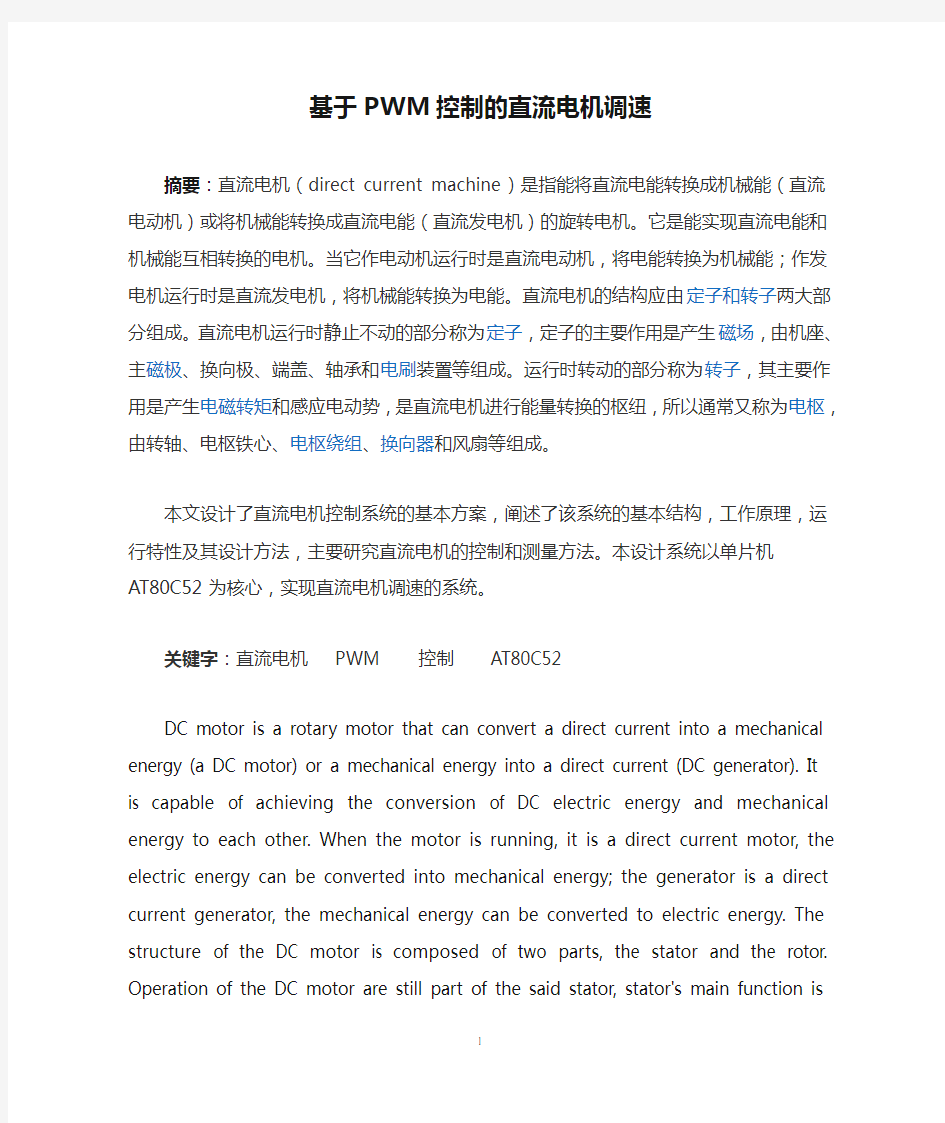基于PWM控制的直流电机调速

- 1、下载文档前请自行甄别文档内容的完整性,平台不提供额外的编辑、内容补充、找答案等附加服务。
- 2、"仅部分预览"的文档,不可在线预览部分如存在完整性等问题,可反馈申请退款(可完整预览的文档不适用该条件!)。
- 3、如文档侵犯您的权益,请联系客服反馈,我们会尽快为您处理(人工客服工作时间:9:00-18:30)。
基于PWM控制的直流电机调速摘要:直流电机(direct current machine)是指能将直流电能转换成机械能(直流电动机)或将机械能转换成直流电能(直流发电机)的旋转电机。它是能实现直流电能和机械能互相转换的电机。当它作电动机运行时是直流电动机,将电能转换为机械能;作发电机运行时是直流发电机,将机械能转换为电能。直流电机的结构应由定子和转子两大部分组成。直流电机运行时静止不动的部分称为定子,定子的主要作用是产生磁场,由机座、主磁极、换向极、端盖、轴承和电刷装置等组成。运行时转动的部分称为转子,其主要作用是产生电磁转矩和感应电动势,是直流电机进行能量转换的枢纽,所以通常又称为电枢,由转轴、电枢铁心、电枢绕组、换向器和风扇等组成。
本文设计了直流电机控制系统的基本方案,阐述了该系统的基本结构,工作原理,运行特性及其设计方法,主要研究直流电机的控制和测量方法。本设计系统以单片机AT80C52为核心,实现直流电机调速的系统。
关键字:直流电机 PWM 控制 AT80C52
DC motor is a rotary motor that can convert a direct current into a mechanical energy (a DC motor) or a mechanical energy into a direct current (DC generator). It is capable of achieving the conversion of DC electric energy and mechanical energy to each other. When the motor is running, it is a direct current motor, the electric energy can be converted into mechanical energy; the generator is a direct current generator, the mechanical energy can be converted to electric energy. The structure of the DC motor is composed of two parts, the stator and the rotor. Operation of the DC motor are still part of the said stator, stator's main function is produces a magnetic field, is composed of a frame, a main pole, Huan Xiangji, an end cover, a bearing and an electric brush device and composition. Said operation, the rotating part of the rotor, the main role is electromagnetic torque and induction electromotive force generated, the DC motor is the hub of energy conversion, so is often referred to as the armature and is composed of a shaft, the armature core, an armature wining and commutator and fan.
In this paper, the design of the basic scheme of DC motor control system, expounds the basic structure of the system, working principle, operating characteristic and the design method, mainly research on DC motor control and measurement method. The design system based on SCM AT80C52 as the core, to achieve the DC motor speed control sytem.
一、算法概述
1.PID算法
当今的闭环自动控制技术都是基于反馈的概念以减少不确定性。反馈理论的要素包括三个部分:测量、比较和执行。测量关心的是被控变量的实际值,与期望值相比较,用这个偏差来纠正系统的响应,执行调节控制。在工程实际中,应用最为广泛的调节器控制规律为比例、积分、微分控制,简称PID控制,又称PID调节。
PID控制器(比例-积分-微分控制器)是一个在工业控制应用中常见的反馈回路部件,由比例单元P、积分单元I和微分单元D组成。
这个理论和应用的关键是,做出正确的测量和比较后,如何才能更好地纠正系统。
PID(比例(proportion)、积分(integration)、微分(differentiation))控制器作为最早实用化的控制器已有近百年历史,现在仍然是应用最广泛的工业控制器。PID控制器简单易懂,使用中不需精确的系统模型等先决条件,因而成为应用最为广泛的控制器。
PID控制器由比例单元(P)、积分单元(I)和微分单元(D)组成。其输入e (t)与输出u (t)的关系为
u(t)=kp[e(t)+1/TI∫e(t)dt+TD*de(t)/dt] 式中积分的上下限分别是0和t
因此它的传递函数为:G(s)=U(s)/E(s)=kp[1+1/(TI*s)+TD*s]
其中kp为比例系数; TI为积分时间常数; TD为微分时间常数
在过程控制中,按偏差的比例(P)、积分(I)和微分(D)进行控制的PID 控制器(亦称PID调节器)是应用最为广泛的一种自动控制器。它具有原理简单,
